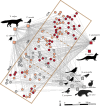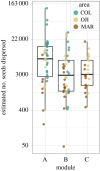The turnover of plant-frugivore interactions along plant range expansion: consequences for natural colonization processes
- PMID: 37221844
- PMCID: PMC10206477
- DOI: 10.1098/rspb.2022.2547
The turnover of plant-frugivore interactions along plant range expansion: consequences for natural colonization processes
Abstract
Plant-animal mutualisms such as seed dispersal are key interactions for sustaining plant range shifts. It remains elusive whether the organization of interactions with seed dispersers is reconfigured along the expansion landscape template and, if so, whether its effects accelerate or slow colonization. Here we analyse plant-frugivore interactions in a scenario of rapid population expansion of a Mediterranean juniper. We combined network analyses with field surveys, sampling interactions between individual plants and frugivores by DNA-barcoding and phototrapping over two seasons. We assess the role of intrinsic and extrinsic intraspecific variability in shaping interactions and we estimate the individual plant contributions to the seed rain. The whole interaction network was highly structured, with a distinct set of modules including individual plants and frugivore species arranged concordantly along the expansion gradient. The modular configuration was partially shaped by individual neighbourhood context (density and fecundity) and phenotypic traits (cone size). Interaction reconfiguration resulted in a higher and more uneven propagule contribution, with most effective dispersers having a prominent role at the colonization front stand, where a distinct subset of early arriving plants dominated the seed rain. Our study offers new insights into the key role of mutualistic interactions in colonization scenarios by promoting fast plant expansion processes.
Keywords: ecological networks; frugivory; mutualistic interactions; plant range shifts; reproductive ecology; seed dispersal.
Conflict of interest statement
We declare we have no competing interests.
Figures




Similar articles
-
From structure to function in mutualistic interaction networks: Topologically important frugivores have greater potential as seed dispersers.J Anim Ecol. 2020 Sep;89(9):2181-2191. doi: 10.1111/1365-2656.13273. Epub 2020 Jun 24. J Anim Ecol. 2020. PMID: 32495479
-
Moving from frugivory to seed dispersal: Incorporating the functional outcomes of interactions in plant-frugivore networks.J Anim Ecol. 2018 Jul;87(4):995-1007. doi: 10.1111/1365-2656.12831. Epub 2018 Apr 20. J Anim Ecol. 2018. PMID: 29603211 Free PMC article.
-
Frugivore species maintain their structural role in the trophic and spatial networks of seed dispersal interactions.J Anim Ecol. 2020 Sep;89(9):2168-2180. doi: 10.1111/1365-2656.13281. Epub 2020 Jul 12. J Anim Ecol. 2020. PMID: 32568426
-
The mutualism-antagonism continuum in Neotropical palm-frugivore interactions: from interaction outcomes to ecosystem dynamics.Biol Rev Camb Philos Soc. 2022 Apr;97(2):527-553. doi: 10.1111/brv.12809. Epub 2021 Nov 1. Biol Rev Camb Philos Soc. 2022. PMID: 34725900 Free PMC article. Review.
-
How intraspecific variation in seed-dispersing animals matters for plants.Biol Rev Camb Philos Soc. 2018 May;93(2):897-913. doi: 10.1111/brv.12377. Epub 2017 Oct 10. Biol Rev Camb Philos Soc. 2018. PMID: 29024277 Review.
Cited by
-
Downscaling mutualistic networks from species to individuals reveals consistent interaction niches and roles within plant populations.Proc Natl Acad Sci U S A. 2025 Feb 18;122(7):e2402342122. doi: 10.1073/pnas.2402342122. Epub 2025 Feb 12. Proc Natl Acad Sci U S A. 2025. PMID: 39937855 Free PMC article.
References
-
- Bascompte J, Jordano P. 2017. Mutualistic networks. Princeton, NJ: Princeton Universtiy Press.
-
- Kissling WD, Schleuning M. 2015. Multispecies interactions across trophic levels at macroscales: retrospective and future directions. Ecography (Cop.) 38, 346-357. (10.1111/ecog.00819) - DOI
-
- Bronstein J. (ed.) 2015. Mutualism. Oxford, UK: Oxford University Press.
Publication types
MeSH terms
Associated data
LinkOut - more resources
Full Text Sources

